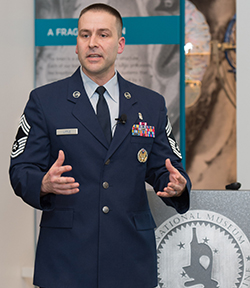Air Force Medicine: Anytime, Anywhere in the World
By Lauren Bigge
NMHM Public Affairs Coordinator
The U.S. Air Force (USAF) Medical Service assures that the service deploys a medically-fit force and educates airmen to become medical professionals, according to Chief Master Sgt. David J. Little, Chief, Medical Operations and Research, Office of the Air Force Surgeon General. Little shared the history and mission of the Air Force's medical service during the National Museum of Health and Medicine's Feb. 28 Medical Museum Science Café.
"My purpose is to highlight the Air Force Medical Service - how we take care of our airmen, make sure we have them in the right place at the right time, with the right, appropriate training to take care of that downrange mission," he began. "We operationally support the Air Force, and we do so by being lighter, leaner and faster."
Chief Little assists with ensuring a quality, cost-effective, preventive-based health care continuum for 2.6 million beneficiaries worldwide. His responsibilities include policy execution for 44,000 personnel and 75 medical treatment facilities, with a budget of more than $6.4 billion.
Air Force medical operations operate 24/7, anywhere in the world; nearly 800 Air Force medics are deployed to 22 countries. One C-17 airplane can accommodate a Health Response Team (HRT) of 40 medics, and wherever they land, patients may be treated within as little as 15 minutes. An emergency room and intensive care unit can be set up and ready for patients in less than six hours.
"It's a tribute to what we can do in a lean, faster, more efficient and effective manner," Chief Little said. "Based on the population at risk, we can increase that. The HRT can handle from zero up to about 5,000 individuals."
In an aeromedical evacuation, three technicians and two flight nurses treat up to 50 patients in a contingency situation. Critical Care Air Transport (CCAT) and Tactical Critical Care Evacuation Teams (TCCET) move thousands of ICU-level patients. An ER doctor and a cardiology-respiratory technician accompany a CCAT, so patients can be stabilized in flight. A TCCET team flight includes a surgeon and nurse anesthetist, so patients can undergo operations.
NMHM features Air Force medicine in an exhibit titled "Trauma Bay II." The museum collected part of a floor from an Air Force tent hospital that was in operation from 2003-2007 at the Balad Air Base north of Baghdad, Iraq. The Balad theater hospital was the primary evacuation hospital for American service members treated in country. "Trauma Bay II" is where the most grievously wounded were triaged and became known anecdotally as the place where the most American lives were saved or lost since Vietnam. The exhibit shares the story of battlefield medicine during the current conflicts and helps also share the story of CCAT teams which evolved to extend the continuum of care from the battlefield to hospitals in Europe and the U.S.
Training and education are crucial. Global Health Engagement in the Air Force began in the early 2000s as an international health specialist program. Airmen gain their knowledge and skills at the Air Force-Navy's Defense Institute of Medical Operations (DIMO) at Lackland Air Force Base, San Antonio, Texas. The Departments of Defense and State deploy mobile training teams, provided by DIMO, to share more than 35 courses with other nations, including disaster preparedness, public health and infectious diseases, and trauma casualty care.
"Sixty-five officers and enlisted go out and train other nations on how to take care of patients in a contingency or war-time environment," he said.
NMHM's Medical Museum Science Cafes are a regular series of informal talks that connect the mission of the Department of Defense museum with the public. NMHM was founded as the Army Medical Museum in 1862 and moved to its current location in Silver Spring, Maryland, in 2012. NMHM is an element of the Defense Health Agency. For more information on upcoming events, please call 301-319-3303 or visit www.medicalmuseum.mil.
Click any photo to view larger version




